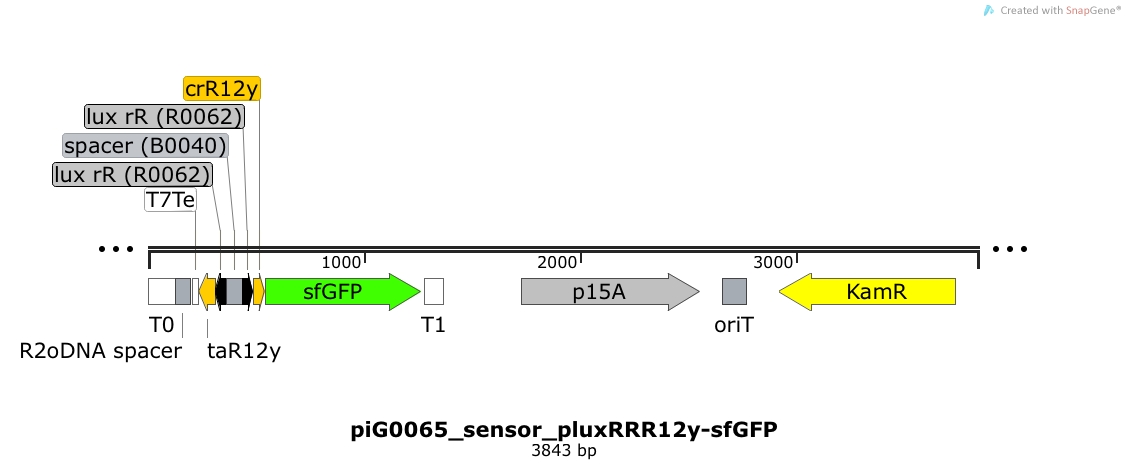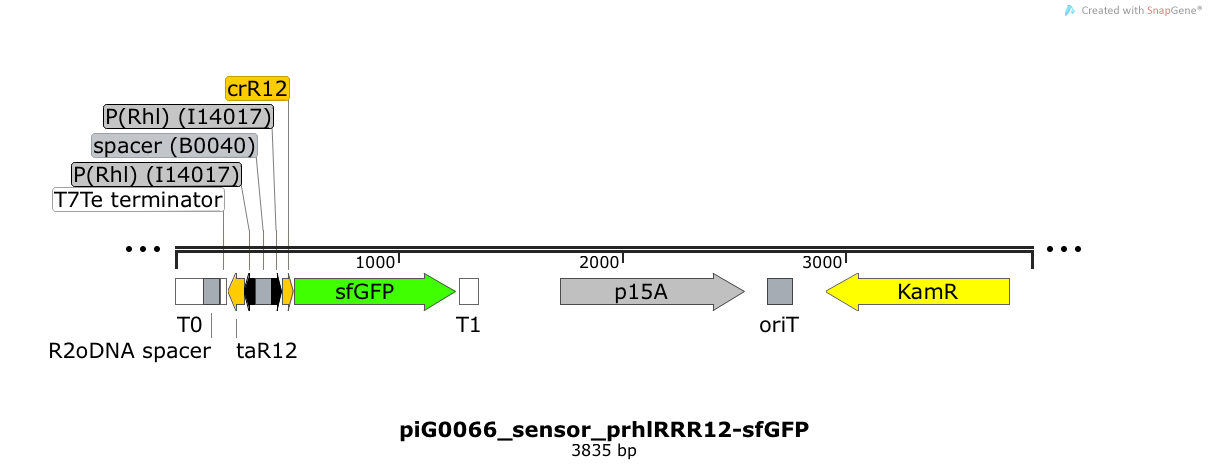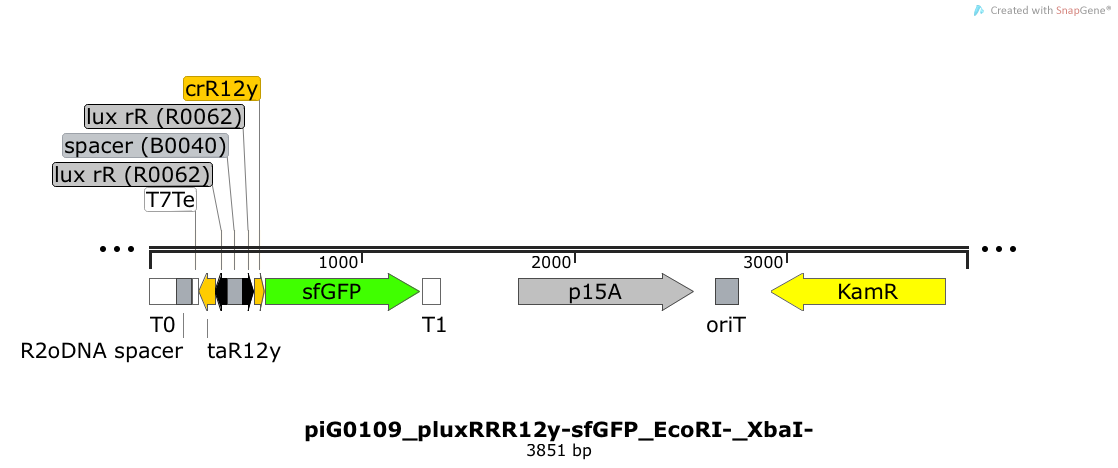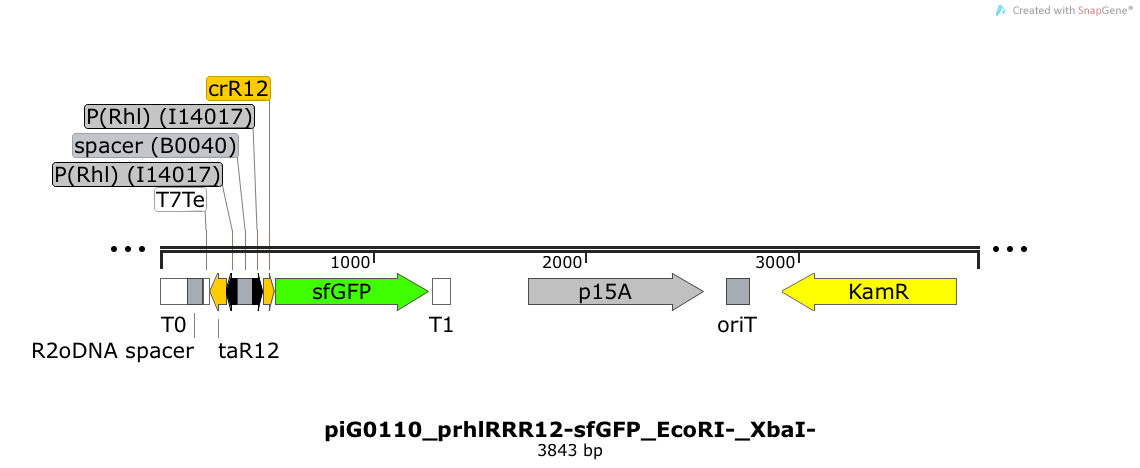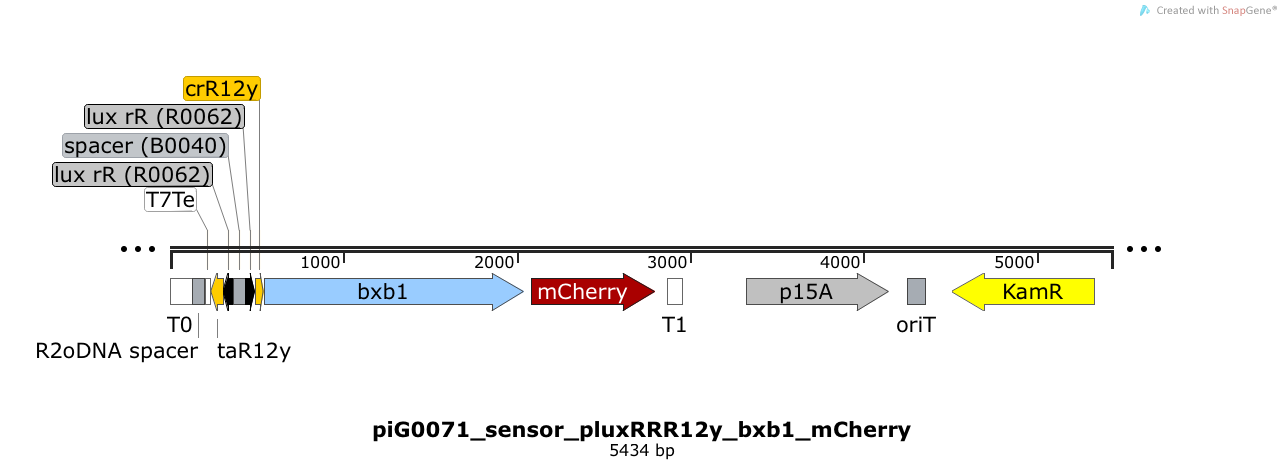Team:ETH Zurich/lab/sequences
From 2014.igem.org
(→Combined Sensor and Producer Constructs) |
|||
| Line 18: | Line 18: | ||
[[Team:ETH_Zurich/lab/sequences#Combined_Sensor_and_Producer_Constructs|Combined Sensor and Producer Constructs]] | [[Team:ETH_Zurich/lab/sequences#Combined_Sensor_and_Producer_Constructs|Combined Sensor and Producer Constructs]] | ||
| + | |||
| Line 68: | Line 69: | ||
[[File:ETH2014_piG0047_Map.png|link=https://static.igem.org/mediawiki/2014/1/1b/ETH2014_piG0047.txt]] | [[File:ETH2014_piG0047_Map.png|link=https://static.igem.org/mediawiki/2014/1/1b/ETH2014_piG0047.txt]] | ||
| + | |||
| + | |||
| + | |||
==Producer Constructs== | ==Producer Constructs== | ||
| + | |||
[https://static.igem.org/mediawiki/2014/4/43/ETH2014_piG0049.txt piG0049] | [https://static.igem.org/mediawiki/2014/4/43/ETH2014_piG0049.txt piG0049] | ||
| Line 114: | Line 119: | ||
[[File:ETH2014_piG0051max_Map.png|link=https://static.igem.org/mediawiki/2014/9/94/ETH2014_piG0051max.txt]] | [[File:ETH2014_piG0051max_Map.png|link=https://static.igem.org/mediawiki/2014/9/94/ETH2014_piG0051max.txt]] | ||
| + | |||
| + | |||
| + | |||
==Sensor Constructs== | ==Sensor Constructs== | ||
| + | |||
[https://static.igem.org/mediawiki/2014/a/a7/ETH2014_piG0058_sensor_plasRstRBS-sfGFP.txt piG0058] | [https://static.igem.org/mediawiki/2014/a/a7/ETH2014_piG0058_sensor_plasRstRBS-sfGFP.txt piG0058] | ||
| Line 173: | Line 182: | ||
[[File:ETH2014 piG0067 logic bxb1 BUFFER-sfGFP Map.png|link=https://static.igem.org/mediawiki/2014/5/59/ETH2014_piG0067_logic_bxb1_BUFFER-sfGFP.txt]] | [[File:ETH2014 piG0067 logic bxb1 BUFFER-sfGFP Map.png|link=https://static.igem.org/mediawiki/2014/5/59/ETH2014_piG0067_logic_bxb1_BUFFER-sfGFP.txt]] | ||
| + | |||
| + | |||
| + | |||
==Signal Propagation Construct== | ==Signal Propagation Construct== | ||
| + | |||
[https://static.igem.org/mediawiki/2014/1/1d/ETH2014_piG0071_sensor_pluxRRR12y_bxb1_mCherry.txt piG0071] | [https://static.igem.org/mediawiki/2014/1/1d/ETH2014_piG0071_sensor_pluxRRR12y_bxb1_mCherry.txt piG0071] | ||
| Line 181: | Line 194: | ||
[[File:ETH2014 piG0071 sensor pluxRRR12y bxb1 mCherry Map.png|link=https://static.igem.org/mediawiki/2014/1/1d/ETH2014_piG0071_sensor_pluxRRR12y_bxb1_mCherry.txt]] | [[File:ETH2014 piG0071 sensor pluxRRR12y bxb1 mCherry Map.png|link=https://static.igem.org/mediawiki/2014/1/1d/ETH2014_piG0071_sensor_pluxRRR12y_bxb1_mCherry.txt]] | ||
| + | |||
| + | |||
| + | |||
==Combined Sensor and Producer Constructs== | ==Combined Sensor and Producer Constructs== | ||
| + | |||
[https://static.igem.org/mediawiki/2014/f/f5/ETH2014_piG0096_pluxRRR12y-sfGFP-maxRBS-luxI.txt piG0096] | [https://static.igem.org/mediawiki/2014/f/f5/ETH2014_piG0096_pluxRRR12y-sfGFP-maxRBS-luxI.txt piG0096] | ||
Revision as of 21:20, 17 October 2014
Sequences
The plasmid sequences can be accessed by clicking on the plasmid name (e.g. piG0040) or the plasmid picture.
Construct types:
Combined Sensor and Producer Constructs
Regulator Constructs
LasR is expressed under the strong constitutive promoter [http://parts.igem.org/Part:BBa_J23100 BBa_J23100] while the expression level is influenced by the RBS [http://parts.igem.org/Part:BBa_B0034 BBa_B0034]. LasR bound to 3OC12-HSL induces the expression of genes under the control of pLasR. The plasmid pBR322 and its derivatives have a copy number of 15 to 20[15].
LuxR is expressed under the strong constitutive promoter [http://parts.igem.org/Part:BBa_J23100 BBa_J23100] while the expression level is influenced by the RBS [http://parts.igem.org/Part:BBa_B0034 BBa_B0034]. LuxR bound to 3OC6-HSL induces the expression of genes under the control of pLuxR. The plasmid pBR322 and its derivatives have a copy number of 15 to 20[15].
RhlR is expressed under the strong constitutive promoter [http://parts.igem.org/Part:BBa_J23100 BBa_J23100] while the expression level is influenced by the RBS [http://parts.igem.org/Part:BBa_B0034 BBa_B0034]. RhlR bound to C4-HSL induces the expression of genes under the control of pRhlR. The plasmid pBR322 and its derivatives have a copy number of 15 to 20[15].
RhlR is expressed under the strong constitutive promoter [http://parts.igem.org/Part:BBa_J23100 BBa_J23100] while the expression level is influenced by an RBS optimised for RhlR (RBS calculator). RhlR bound to C4-HSL induces the expression of genes under the control of pRhlR. The plasmid pBR322 and its derivatives have a copy number of 15 to 20[15].
LuxR is expressed under the weak constitutive promoter [http://parts.igem.org/Part:BBa_J23109 BBa_J23109] while the expression level is influenced by the RBS [http://parts.igem.org/Part:BBa_B0034 BBa_B0034]. LuxR bound to 3OC6-HSL induces the expression of genes under the control of pLuxR. The plasmid pBR322 and its derivatives have a copy number of 15 to 20[15].
LuxR is expressed under the medium strong constitutive promoter [http://parts.igem.org/Part:BBa_J23111 BBa_J23111 ] while the expression level is influenced by the RBS [http://parts.igem.org/Part:BBa_B0034 BBa_B0034]. LuxR bound to 3OC6-HSL induces the expression of genes under the control of pLuxR. The plasmid pBR322 and its derivatives have a copy number of 15 to 20[15].
Producer Constructs
LasI is expressed under the strong constitutive promoter [http://parts.igem.org/Part:BBa_J23100 BBa_J23100 ] while the expression level is influenced by the RBS [http://parts.igem.org/Part:BBa_B0034 BBa_B0034]. LasI produces the quorum sensing molecule 3OC12-HSL. The pBBR1 origin is present at a copy number of approximately 5, however, the origin is poorly characterized [16].
LasI is expressed under the strong constitutive promoter [http://parts.igem.org/Part:BBa_J23100 BBa_J23100 ] while the expression level is increased by an RBS optimised for LasI (RBS calculator). LasI produces the quorum sensing molecule 3OC12-HSL. The pBBR1 origin is present at a copy number of approximately 5, however, the origin is poorly characterized [16].
LuxI is expressed under the strong constitutive promoter [http://parts.igem.org/Part:BBa_J23100 BBa_J23100 ] while the expression level is influenced by the RBS [http://parts.igem.org/Part:BBa_B0034 BBa_B0034]. LuxI produces the quorum sensing molecule 3OC6-HSL. The pBBR1 origin is present at a copy number of approximately 5, however, the origin is poorly characterized[16].
LuxI is expressed under the strong constitutive promoter [http://parts.igem.org/Part:BBa_J23100 BBa_J23100 ] while the expression level is increased by an RBS optimised for LuxI (RBS calculator). LuxI produces the quorum sensing molecule 3OC6-HSL. The pBBR1 origin is present at a copy number of approximately 5, however, the origin is poorly characterized[16].
RhlI is expressed under the strong constitutive promoter [http://parts.igem.org/Part:BBa_J23100 BBa_J23100 ] while the expression level is influenced by the RBS [http://parts.igem.org/Part:BBa_B0034 BBa_B0034]. RhlI produces the quorum sensing molecule C4-HSL. The pBBR1 origin is present at a copy number of approximately 5, however, the origin is poorly characterized[16].
RhlI is expressed under the strong constitutive promoter [http://parts.igem.org/Part:BBa_J23100 BBa_J23100 ] while the expression level is increased by an RBS optimised for RhlI (RBS calculator). RhlI produces the quorum sensing molecule C4-HSL. The pBBR1 origin is present at a copy number of approximately 5, however, the origin is poorly characterized[16].
Sensor Constructs
Expression of sfGFP is induced when LasR bound to 3OC12-HSL bind to pLasR. The p15A is present at a copy number of approximately 15 to 25[35].
Expression of sfGFP is induced when LuxR bound to 3OC6-HSL bind to pLuxR. The p15A is present at a copy number of approximately 15 to 25[35].
Expression of sfGFP is induced when RhlR bound to 4C-HSL bind to pRhlR. The p15A is present at a copy number of approximately 15 to 25[35].
Expression of sfGFP is induced when LuxR bound to 3OC6-HSL bind to pLuxR. The cis-repressive element (crR12y) inhibits the translation of sfGFP, since the RBS is blocked by secondary structures of the mRNA. The p15A is present at a copy number of approximately 15 to 25[35].
Expression of sfGFP is induced when LuxR bound to 3OC6-HSL bind to pLuxR. The cis-repressive element (crR12y) inhibits the translation of sfGFP, since the RBS is blocked by secondary structures of the mRNA. The transcript of the trans-activating element (taR12y) binds to the transcript of the cis-repressive element, hence the RBS is not blocked anymore. The two elements build a riboregulator that decreases leakiness of pLuxR. A biologically neutral spacer sequence was designed using the web application R2oDNA[34]. The p15A is present at a copy number of approximately 15 to 25[35].
Expression of sfGFP is induced when RhlR bound to 4C-HSL bind to pRhlR. The cis-repressive element (crR12) inhibits the translation of sfGFP, since the RBS is blocked by secondary structures of the mRNA. The transcript of the trans-activating element (taR12) binds to the transcript of the cis-repressive element, hence the RBS is not blocked anymore. The two elements build a riboregulator that decreases leakiness of pLuxR. A biologically neutral spacer sequence was designed using the web application R2oDNA[34]. The p15A is present at a copy number of approximately 15 to 25[35].
Expression of sfGFP is induced when LuxR bound to 3OC6-HSL bind to pLuxR. The cis-repressive element (crR12y) inhibits the translation of sfGFP, since the RBS is blocked by secondary structures of the mRNA. The transcript of the trans-activating element (taR12y) binds to the transcript of the cis-repressive element, hence the RBS is not blocked anymore. The two elements build a riboregulator that decreases leakiness of pLuxR. A biologically neutral spacer sequence was designed using the web application R2oDNA[34]. The p15A is present at a copy number of approximately 15 to 25[35]. PiG0109 is a derivate of piG0065 where the restriction sites EcoRI and XbaI have been removed. Thus, the two constructs slightly differ in the sequence of the 3'-end of the trans-activating element and in the sequence of the 5'-end of the cis-repressive element.
Expression of sfGFP is induced when RhlR bound to 4C-HSL bind to pRhlR. The cis-repressive element (crR12) inhibits the translation of sfGFP, since the RBS is blocked by secondary structures of the mRNA. The transcript of the trans-activating element (taR12) binds to the transcript of the cis-repressive element, hence the RBS is not blocked anymore. The two elements build a riboregulator that decreases leakiness of pLuxR. A biologically neutral spacer sequence was designed using the web application R2oDNA[34]. The p15A is present at a copy number of approximately 15 to 25[35]. PiG0110 is a derivate of piG0066 where the restriction sites EcoRI and XbaI have been removed. Thus, the two constructs slightly differ in the sequence of the 3'-end of the trans-activating element and in the sequence of the 5'-end of the cis-repressive element.
BUFFER Gate Construct
The directional terminator [http://parts.igem.org/Part:BBa_B0015 BBa_B0015] blocks transcription of sfGFP under the strong constitutive promoter [http://parts.igem.org/Part:BBa_J23100 BBa_J23100]. Only if the integrase Bxb1 flips B0015 between the attP and the attB sites, transcription of sfGFP is possible. The pBBR1 origin is present at a copy number of approximately 5, however, the origin is poorly characterized[16]
Signal Propagation Construct
Expression of the integrase Bxb1 and the fluorophore mCherry is induced when LuxR bound to 3OC6-HSL bind to pLuxR. The cis-repressive element (crR12y) inhibits the translation of Bxb1 and mCherry, since the RBS is blocked by secondary structures of the mRNA. The transcript of the trans-activating element (taR12y) binds to the transcript of the cis-repressive element, hence the RBS is not blocked anymore. The two elements build a riboregulator that decreases leakiness of pLuxR. A biologically neutral spacer sequence was designed using the web application R2oDNA[34]. The p15A is present at a copy number of approximately 15 to 25[35].
Combined Sensor and Producer Constructs
Expression of sfGFP and LuxI is induced when LuxR bound to 3OC6-HSL bind to pLuxR. The cis-repressive element (crR12y) inhibits the translation of the succeeding gene, since the RBS is blocked by secondary structures of the mRNA. The transcript of the trans-activating element (taR12y) binds to the transcript of the cis-repressive element, hence the RBS is not blocked anymore. The two elements build a riboregulator that decreases leakiness of pLuxR. The expression level of LuxI is increased by an RBS optimised for LuxI (RBS calculator). A biologically neutral spacer sequence was designed using the web application R2oDNA[34]. The p15A is present at a copy number of approximately 15 to 25[35].
Expression of sfGFP and LuxI is induced when LuxR bound to 3OC6-HSL bind to pLuxR. The cis-repressive element (crR12y) inhibits the translation of the succeeding gene, since the RBS is blocked by secondary structures of the mRNA. The transcript of the trans-activating element (taR12y) binds to the transcript of the cis-repressive element, hence the RBS is not blocked anymore. The two elements build a riboregulator that decreases leakiness of pLuxR. The expression level of LuxI is influenced by the RBS [http://parts.igem.org/Part:BBa_B0034 BBa_B0034]. A biologically neutral spacer sequence was designed using the web application R2oDNA[34]. The p15A is present at a copy number of approximately 15 to 25[35].
Expression of sfGFP and LuxI is induced when LuxR bound to 3OC6-HSL bind to pLuxR. The expression level of sfGFP and LuxI is influenced by the RBS [http://parts.igem.org/Part:BBa_B0034 BBa_B0034]. The p15A is present at a copy number of approximately 15 to 25[35].
 "
"


















